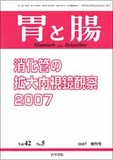Japanese
English
- 有料閲覧
- Abstract 文献概要
- 1ページ目 Look Inside
- 参考文献 Reference
要旨 内視鏡的ないし外科的に切除された標本を,ホルマリン固定後に塩酸消化法にて単離してpit patternに対応する腺管の三次元構築を検討した.I型pit patternに対応する正常腺管は,表面平滑な試験管状であり分枝や結節は認めなかった.II型pit patternに対応する過形成腺管は,腺頸部で広く腺底部で細くなるような逆三角形や,腺底部から裂開するような分枝状であるが表面平滑で結節は認めなかった.IIIL型pit patternに対応する腫瘍腺管は,逆三角形ないし舌状であり,表面はI型やII型の対応腺管に比し粗ぞうで,小結節や切れ込みを伴う腺管も認めた.IIIs型pit patternに対応する腫瘍腺管は,表面はI型やII型の対応腺管に比しやや粗であるが分枝や結節のない単一な腺管で,腺底部(粘膜筋板に接する位置)で先細りし屈曲していた.IV型pit patternに対応する腫瘍腺管は,ここに提示した分枝を伴う長く伸びた腺口形態を反映して,結節を多く伴う表面粗ぞうな腺管であった.V型pit patternに対応する腺管は,統一性を欠く様々な構造を呈する,“奇怪な”形態の腺管の集合から成っていた.
This study examined the relationship between pit patterns and the three-dimensional configuration of neoplastic gland and evaluated it for its contribution toward an understanding of the pit pattern. Pit patterns were classified into6types. For the crypt isolation, the HCl-digestion method was used. Isolated crypts with the type I pit pattern resembled a test-tube, the type II pit pattern was also tubular but had obserrable fissures at the bottom, the type IIIL pit pattern was like a reversed triangle or tongue-like in shape, and the type IIIs pit pattern was columnar and either tapered off or meandered. The isolated crypts with the type IV pit pattern appeared as long reversed triangles with protuberances. The isolated crypts with the type V pit pattern were complicated and indistinct in shape. Evaluation of the three-dimensional configuration revealed that each isolated crypt, which corresponded to each pit pattern differed in shape. Recognition of the differences in the three-dimensional configuration should contribute toward an understanding of pit pattern diagnosis and further development of the endoscopic diagnosis of various colorectal lesions.

Copyright © 2007, Igaku-Shoin Ltd. All rights reserved.


